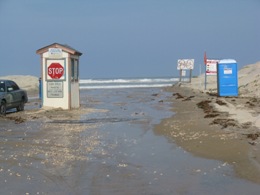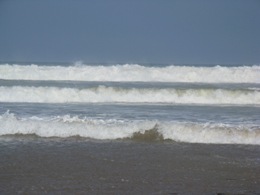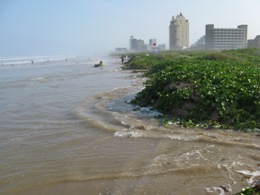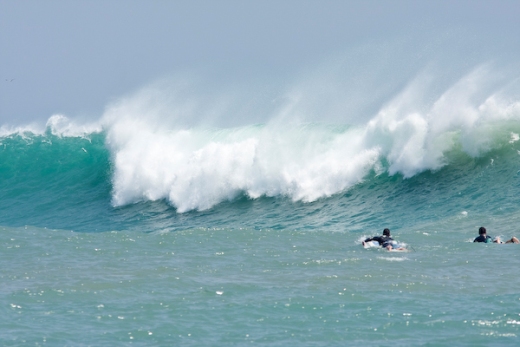|
As expected, swells generated by a growing (in size) Hurricane Gustav, which moved northwest from western Cuba toward the southeast Louisiana coast in a little over 30 hours between late evening August 30th and early morning on Labor Day, September 1st 2008, hustled onto the Deep South Texas by late morning, and continued into the evening before quickly receding overnight and during the morning of September 2nd. While the relatively fast movement of Gustav limited the high surf and dangerous current to one calendar day, it was quite a day, indeed!
Surf
For surfers, September 1st 2008 will be a day to remember. Meteorologically, conditions aligned nearly perfect for a great afternoon of surfing, particularly near jetties and piers, where constructive interference provided by these structures built waves of 12 feet or more, according to local surfing aficionados. The "perfect" conditions included virtually no wind, courtesy of a light background northwesterly flow well to the west of the center of Gustav, counteracted by a limited sea breeze. Hence, the waves along South Padre Island were purely swell driven, which allows for largely clean breaks and curl. These conditions were verified by maritime observations from NOAA Buoy 42020, which indicated a light west wind of only 4 knots, but combined seas of 7 to 8 feet, and most importantly, a swell period of 13 to 14 seconds.
Accompanying the surf was the typical loud ocean-like roar, which is seldom heard along the Deep South Texas coast except in cases like these, as well as during landfalling hurricanes and, in the right situation, significant winter storms. Click here for a short video, with sound, of the continuous breaking waves. Note: Windows Media Player or other software able to resolve .avi files is necessary to play this clip.
|
Tides and Currents
Unfortunately, "Surfers' Delight" normally comes with consequences for others, including dangerous rip currents and at least minor coastal flood issues. These same swells produced long wavelengths, of which the final set at the shoreline drove well beyond the normal location, flooding the beaches with up to 2 feet of water, or a little more, in some cases, especially as astronomical tides were rising during the mid to late afternoon. At high tide, water reached 2 to 3 feet at the dune line (above), which easily surged through dune breaks, such as Beach Access 6 (below). While this was a critical hazard for those who normally drive along the beach, there was only a brief period when the water reached across State Highway 100. No flooding was observed in the Gulf front resort area. Though no gages were available along the beach, it was estimated that tide departures approaching 3 feet above normal occurred.

Along with the high surf and high tides came a fierce undertow, and likely some dangerous rip currents. Fortunately, despite the hot and dry weather across the Lower Rio Grande Valley, non surfing crowds were fairly light, and those that did venture into the surf were cautious. As of this writing, there have been no drownings reported on Labor Day. Kudos to residents and visitors alike for staying safe on Labor Day, 2008.
|



